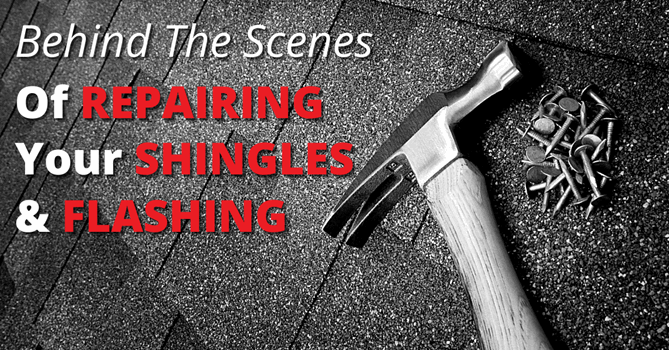Behind The Scenes Of Repairing Your Shingles And Flashing

Sunlight, moisture, and temperature fluctuations are hard on shingles, exposing them to damage and deterioration. In most cases, this damage comes in the form of lifting, curling, or blown off shingles. Roof flashing is another element which plays a critical role in maintaining your roof’s integrity but can be damaged or deteriorate over time.
If left unchecked, deteriorating shingles and flashing can cause significant damage and more expenses for homeowners. Here are some of the main factors which cause shingle damage and what you can do to fix them.
Why Shingles Curl
- Low-quality roof shingles: Manufacturing issues may cause shingles to start curling.
- Insufficient attic ventilation: Hot, moisture-filled air in your home rises to the attic. If your attic doesn’t have enough ventilation, heat and moisture will build up in the attic and bake the shingles from the inside out.
- Improper installation: The wrong types of nail, improperly placed nails, or a lack of proper adhesive cause wear and tear.
- Old age: If your roof was installed more than 15 years ago and the shingles are curling, it’s probably because the roof has reached its lifespan.
- Multiple shingle layers: If you chose to lay new shingles over the old, the shingles at the top may not seal correctly. They’re easily curled by high winds and damaged by heat or moisture.
- Cold temperatures: A sudden drop in temperature can cause curling.
Why Shingles Lift
- Installation issues: If the roofer did not use enough nails, nailed them too deeply or shallowly, or didn’t align the adhesive strip correctly, your shingles are bound to lift.
- Bad ventilation: Poor attic ventilation allows moisture to become trapped below the decking and cause the shingles to lift.
- Organic growth: If moss and algae begin to grow on the shingles, their roots can penetrate beneath the shingles and gradually lift them up.
- Foot traffic: Dropping tools or shifting, turning, and spinning on heels.
- Old roofing material: The adhesive seals of your shingles become ineffective as your roof approaches the end of its lifespan. The adhesive weakens its hold and makes shingle lifting possible.
Why Shingles Blow Off
- Not installed correctly: Nails being placed too high up on the shingles provide inadequate holding power.
- New Roof: If your roof was recently installed, there’s the possibility the seal strips have not properly set.
- Underlying roof damage: If the decking is damaged, rotted, or warped, nails can pop and cause the shingles to blow off the roof.
- Old age: The adhesive seals lose their ability to join shingles as the roof ages, increasing the possibility of shingles blowing off.
- High winds: A loose shingle can allow wind to get caught under it, causing a large part of the roof to get blown off the house.
How to Fix Curling, Lifting, or Blown Off Shingles
The most cost-effective way of fixing curling, lifting, or blown off shingles is to get them replaced with new shingles. This can be done if the problem is not widespread.
It’s important to remember, though, replacing the few damaged shingles is a temporary fix. There’s likely a larger issue at play and unless it’s addressed, you could experience the same problem over and over again.
It’s in your best interest to have an experienced roofing contractor take a look at your roof and let you know what’s going wrong. If your roof is old and nearly all the shingles are curling, lifting, or blown off, it’s likely time to have a new roof installed.
Understanding How Roof Flashing Helps Your Roof
While shingles are strong, durable, and designed to provide primary protection against weather, they can’t completely seal joints or corners. This is where roof flashing comes in.
Roof flashing is a thin metal strip used to direct water away from areas of the roof susceptible to leaks. It is installed on roof edges, junctions, valleys, and around chimneys, skylights, and vents.
Over time, flashing can warp, crack, rust, or blow off, exposing the roof to leaks and water damage. Common causes of flashing damage include poor installation, poor repairs, foot traffic, age and exposure, and heavy snow and ice.
Your roofer will inspect your roof to determine the actual condition of your flashing, cause of damage, and the most appropriate solution.
Work With a Reliable Roofer to Repair Shingles and Flashing
Do not try to get up on the ladder and nail down the shingles and roof flashing. You’re better off letting a pro do it. Professional roofers have the training and expertise to safely walk on the roof, diagnose roofing problems, and make accurate, long-term repairs.
You can count on the team at Couto Construction for exceptional roof repair and replacement services. Contact us to schedule a free, no-obligation inspection and estimate in Southeastern Massachusetts, Cape Cod, and Rhode Island.